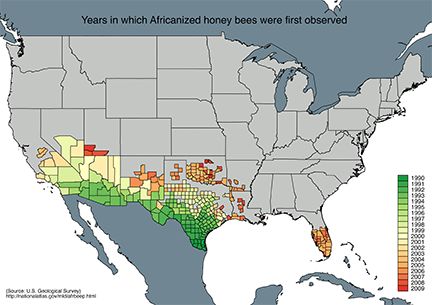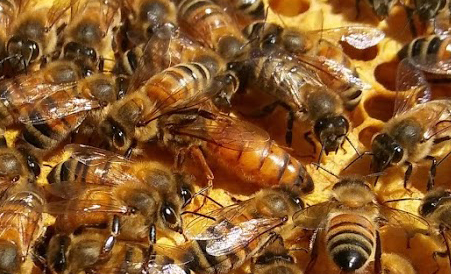In 1957 a biologist named Warwick E. Kerr was trying to figure out how to maintain a honeybee population in the hot and moist climate of Brazil. During his research he figured out that the most productive bees on earth came from southern Africa. His idea then was to import some African honeybees and experimentally cross breed them with his European bees. It went well and was informative until a visiting beekeeper removed the queen excluders from the bottom of the hives that were there to prevent these imported bees from swarming. 26 hives swarmed out of Sau Paulo, Brazil and started proving their effectiveness as they spread and infiltrated hives with record speed.
The African bees that were brought over exhibited a restless attitude, staying in one place until its available forage dwindled and then taking off to another location. That characteristic was very helpful in the desert in Africa where bees need to migrate with the seasons in order to stay alive. That restlessness made it impossible to track or recover the bees and they very quickly started moving north. Some experts have said that they moved north at a rate of 200 – 300 miles per year. At any rate, they were found in Southern Texas in 1990 and quickly started gaining a notorious reputation.

When the African bees started expanding throughout South and Central America they were breeding with and usurping European hives, essentially creating a hybrid now known as Africanized bees. The tendency to usurp existing hives created an immediate problem for beekeepers because one week they had gentle European bees and the next week, after usurpation, they were ultra-aggressive, with far more guard bees and a willingness to chase would be targets for up to a half of a mile, as opposed to around 50 yards for European bees.
The hybridization has made these aggressive bees more adaptable to United States climates and allowed for Africanized bees to steadily move north throughout the Continental United States. The eventual northern ceiling for Africanized bees is a relative question though. As they move north and adapt to the new colder climates they are more and more hybridized, keeping some traits of the original African bees and adopting traits from European bees living in the area. So, as they move farther and farther north, they are less and less Africanized. As of now, confirmed Africanized bee sightings are reaching Florida, Alabama, Louisiana, Oklahoma, Arkansas, Texas, New Mexico, Utah, Nevada, Arizona and California. Their rapid pace of advancement has slowed greatly due to the lack of traits necessary to survive colder climates. For the majority of us in the Continental United States, we have a while before these problematic bees start to uproot our normal beekeeping strategies. One thing that may end up raising their “Northern Ceiling” is climate change. As our winters become more and more mild, the region of habitability grows farther and farther North.
The actual difference between Africanized bees and our much loved and familiar European bees is very small and difficult to identify. The only way to visually identify the difference is to carefully measure the wings. Africanized bees are very slightly smaller, with wings 1 -2 mm shorter than European bees. The major and more obvious differences are their behavioral traits; increased aggressiveness, more bees per hive dedicated to guarding the entrance, their willingness to inhabit different and less suitable hive locations and their increased tendency to swarm.
Other than the problematic aggressiveness some of the traits of these Africanized bees can be helpful to our overall problem of honeybee population decline. Their assiduousness that allows survival in some of the harshest, hottest areas of the United States may also allow for our honeybee population to be more resilient to the threats that are currently plaguing the beekeeping industry.
So, the question remains, how scared should we be? Well, we should remember these bees are not monsters, nor are they malicious and nefarious. They are honeybees that had to adapt to a harsher environment and those defensive characteristics have made them very good at spreading throughout America’s hotter and dryer climates. If you live in Arizona, like my sister, and you come across a swarm of bees you should stay away and call a capable beekeeper to take care of the issue. Each year, nationwide, around 55 people die from allergic reactions to bee stings but only between 3 and 8 people who were not allergic to bees die from honeybee attacks.
References :
USDA – Honeybee Research: Africanized Bees
United States Geological Survey

